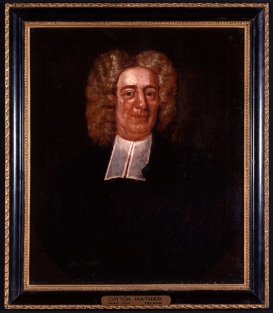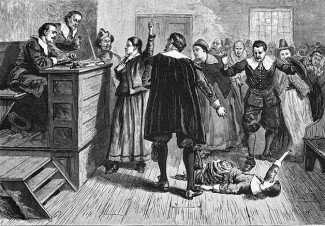The hysteria of the Salem Witch Trials doesn’t happen on its own. What precedent helped establish the ideas of a witch conspiracy in 1692? A case in 1688 provided a backdrop for Salem. A Boston woman hanged for the crime, but how does this appear in 1692? This narrative drawn from primary sources details the case of the Goodwin children and the accusation of Goody Glover. After the execution of Glover, I switch to texts from 1692 describing similar afflictions as documented in 1689.

From Early English Books Online
In 1684, Increase published “Remarkable Providences: An Essay for the Recording of Illustrious Providences” in which he states, “In Order to the promoving of a design of this Nature, so as shall be indeed for Gods Glory, and the good of Posterity, it is necessary that utmost care shall be taken that All, and Only Remarkable Providences be Recorded and Published.” The senior Mather asked for works published on these instances of divine intervention as a way to help keep the pews filled in his church, and Increase was not the first to write on the subject. In the 1660s, Joseph Glanvill and other authors sought stories to publish that demonstrated God’s power in society. Increase considered “Floods, Earth-quakes, Thunders…or what ever else shall happen is Prodigious, Witchcrafts, Diabolical Possessions, Remarkable Judgements upon noted Sinners…to be reckoned among Illustrius Providences.” Cotton Mather also took note of this shift towards writings that emphasized divine actions in the world. Cotton vowed in 1681, “to be diligent in observing and recording of illustrious Providences,” and took an opportunity in 1688.
“I see what pains Mr. Baxter, Mr. Glanvill, Dr. More, and several other Great Names

From the American Antiquarian Society
have taken to publish Histories of Witchcrafts & Possessions unto the world. I said Let me also run after them,” wrote Cotton in the introduction of “Memorable Providences Relating to Witchcrafts and Possessions.” In this book, the younger Mather took up the same cause his father picked up a few years early to publish cases of remarkable providences. Cotton documented the case of the Goodwin children and their afflictions attributed to witchcraft. These children suffered strange symptoms, “Sometimes they would be Deaf, sometimes Dumb, and sometimes Blind, and often, all this at once. One while their Tongues would be drawn down their Throats…They would have their Mouths opened unto such a wideness that their Jaws went out of joint…The same would happen to their Shoulder-Blades, and their Elbows, and Hand-wrists…be drawn together as those that are ty’d Neck & Heels,…They would make most pitteous out-cries, that they were cut with Knives, and struck with blows that they could not bear.” The family looked for assistance with this unexplainable phenomenon through prayer and the guidance of local ministers. Prayer helped ease the childrens’ pains, but not enough with a witch still causing their afflictions.
As rumor spread, the Boston magistrates inquired about the situation and John Goodwin, “complained of his Neighbour, the suspected ill woman, whose name was Glover, and being sent for by the Justices, gave such a wretched Account of her self that they saw cause to commit her unto the Gaolers [Jailer’s] Custody.” At this point, Goodwin still needed evidence of Glover’s guilt, but the judges still questioned the woman, asking her if she believed there was a God. Cotton called Glover a “Hag” and refused to record the answer, “too blasphemous and horrible for any Pen of mine to mention.” The questioning process dragged on with difficulty, “the Court could receive Answers from her in none but the Irish, which was her Native Language.” Glover’s attempts at speaking the Lord’s Prayer also failed, raising suspicion around her and the judges kept her in jail for trial. During Glover’s imprisonment, the Goodwin children’s condition improved.
When Glover stood at the bar, “she did plead, it was with Confession rather than Denial of Guilt,” even claiming ownership of poppets, the dolls witches used to enchant victims. The court found their witch and sentenced her to hang. Glover waited in her cell until her execution, but evidently not alone, “she was heard expostulating with a Devil, for his thus deserting her; telling him that Because he had served her so basely and falsly, she had confessed all.” Cotton Mather also paid two visits to speak with Glover before the execution where he asked about the Devil and witches with the help of a translator. Mather included his discoveries in his book: “she used to be at meetings which her Prince and Four more were present at. As for those Four, She told who they were and for her Prince, her account plainly was, that he was the Devil.” Cotton still followed his duty as a minister and asked if Glover would like him to pray for her, but she refused, “she said If Prayer would do her any good, shee could pray for her self.”
On the day of Glover’s execution, she warned “the Children should not be relieved by her Death, for others had a hand in it as well as she,” and Glover was right. The Goodwin children continued to suffer after the hanging. “They would bark at one another like Dogs, and again purr like so many Cats. They would sometimes complain, that they were in a Red-hot Oven, sweating and panting at the same time…They would fly like Geese; and be carried with an incredible swiftness thro the air, having just their Toes now and then upon the ground, and their Arms waved like the Wings of a Bird.” Cotton decided to assist the family by bringing the oldest daughter into his home to tend to her afflictions and also provide the minister a chance to study them, and the move seemed to ease the troubles briefly. Then one day the eldest daughter shouted, “[They] have found me out!” Her afflictions continued and worsened, but improved with prayer and fasting. The cycle continued for weeks until it ended in 1689. Cotton then wrote and published his bestselling book on the case.

Now jump ahead to 1692.
In the home of Rev. Samuel Parris, the Salem Village minister’s daughter Betty and niece Abigail Williams began to suffer strange symptoms that soon spread to Ann Putnam Jr. and Elizabeth Hubbard. Rev. Deodat Lawson visited Salem Village after the first accusations and described the way Abigail “hurryed with Violence to and fro in the room…sometimes making as if she would fly, stretching up her arms as high as she could, and crying Whish, Whish, Whish, several times.” Beverly minister John Hale reported other strange afflictions, “These Children were bitten and pinched by invisible agensts; their arms, necks, and backs turned this way and that way, and returned back again, so it was impossible for them to do of themselves…Sometimes they were taken dumb, their mouths stopped, their throats choaked, their limbs wracked and tormented…I will not enlarge in the description of their cruel Sufferings, because they were in all things afflicted as bad as John Good-wins Children at Boston, in the year 1689. So that he that will read Mr. Mathers Book of Memorable Providences…may Read part of what these Children, and afterwards sundry grown persons suffered by the hand of Satan, at Salem Village, and parts adjacent.”
– Cotton Mather, “Memorable Providences Relating to Witchcrafts and Possessions,” Boston: R.P., 1689, Early English Books Online.
-Increase Mather, “Remarkable Providences: An Essay for the Recording of Illustrious Providences,” Boston: 1684, Early English Books Online.
-Deodat Lawson, “A Brief and True Narrative,” Boston: Benjamin Harris, 1692, Early English Books Online.
-Richard Werking, “Reformation Is Our Only Preservation”: Cotton Mather and Salem Witchcraft,” The William and Mary Quarterly: 29.2, April 1972, 281-290.
-George Lincoln Burr, “From “A Modest Inquiry into the Nature of Witchcraft,” by John Hale, 1702,” In Narratives of the Witchcraft Cases, 1648-1706,. New York: C. Scribner’s Sons, 1914.

You may wish to include in the sources the article that I wrote for the AMERICAN BENEDICTINE REVIEW entitled “A Catholic in a Puritan Society,” It was all about the life of Goody Glover who was hanged as witch in 1688. You can find it in volume 41 (June 1990), pp. 192-208 of that review. I was also instrumental in having that plaque placed in Our Lady of Victory Church (I was responsible for the wording) and in having the Boston City Council apologize in 1988 for the injustice done to that Catholic woman.
LikeLike
I did so above.
LikeLike
For the apology issue by the Boston City Council. See the original document listed below with the posted link.
LINK: https://imgur.com/x2uK8zb
LikeLike